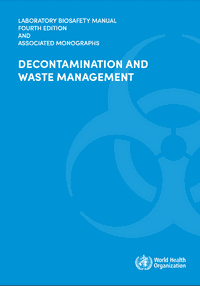LBM, 4th Edition: Decontamination and Waste Management Monograph
[LBM 4: Decontamination and Waste Management]
One of seven monographs associated with the 4th edition of the WHO LBM. This monograph covers decontamination and waste management, a critical step for ensuring the safe handling of biological materials. This monograph describes the methods of disinfection, sterilization and waste management for biological hazards leaving the laboratory.
SUMMARY
The Decontamination and waste management monograph covers decontamination and waste management, a critical step for ensuring the safe handling of biological materials. This monograph describes the methods of disinfection, sterilization and waste management for biological hazards leaving the laboratory. The monograph describes basic methods that can be used to develop lab and material specific protocols, such as chemical disinfectants, fumigation, heat inactivation and handwashing. Proper decontamination is essential for making sure biological materials are contained to the lab, and that the lab remains a safe working environment. The creation of this monograph was funded by Global Affairs Canada, the United States Department of State and the United States Defense Threat Reduction Agency.
This monograph was one of seven associated with the 4th edition of the WHO Laboratory Biosafety Manual (LBM). The LBM guidelines have been globally recognized as a fundamental resource for laboratory biosafety since the first edition was released in 1983. While the standards outlined in this manual are not legally binding, they have become the defacto global standard for biosafety and have inspired many national codes. These guidelines are developed with experts from around the world, and were most recently updated for the fourth edition in 2020, which places a larger emphasis on an evidence and risk based approach to biosafety and biosecurity. Previous editions of the manual have been published in 13 languages, although, as of the last time this library was updated, the 4th edition was only available in English. The development of the manual is led by the Biosecurtity and Health Security Interface at the WHO, a team who also supports national implementation efforts of the International Health Regulations and emergency preparedness.


..png)
